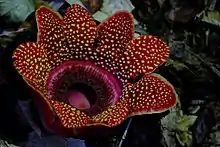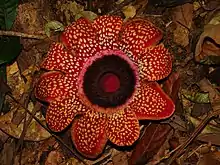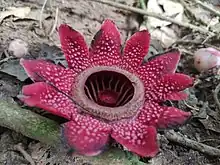| Sapria | |
|---|---|
 | |
| Sapria himalayana | |
| Scientific classification | |
| Kingdom: | Plantae |
| Clade: | Tracheophytes |
| Clade: | Angiosperms |
| Clade: | Eudicots |
| Clade: | Rosids |
| Order: | Malpighiales |
| Family: | Rafflesiaceae |
| Genus: | Sapria Griff.[1] |
| Species[1][2] | |
| |
Sapria is a genus of parasitic flowering plants in the family Rafflesiaceae. It grows within roots of Vitis and Tetrastigma. The genus is limited to the tropical forests of South and Southeast Asia.
The flowers of Sapria are about 20 cm in diameter, bright red with yellow or white dots, unisexual and dioecious. In contrast with the related genus Rafflesia the flowers have 10 lobes.
Species
Four species are described.
| Image | Scientific name | Distribution |
|---|---|---|
 | Sapria himalayana | ifound in Tibet, Assam in northeast India, South-Central China, Myanmar, Thailand and Vietnam. |
| Sapria poilanei | found in Cambodia. | |
 | Sapria ram | found in central and southern Thailand.[1] |
| Sapria myanmarensis | first described in 2019, is native to Myanmar.[2] | |
References
- 1 2 3 "Sapria Griff.", Plants of the World Online, Royal Botanic Gardens, Kew, retrieved 2020-10-27
- 1 2 Tanaka, Nobuyuki; Nagamasu, Hidetoshi; Tagane, Shuichiro; Aung, Mu Mu; Win, Aung Khaing & Hnin, Phyu Phyu (2019), "Contributions to the Flora of Myanmar IV: A new species and a newly recorded taxon of the genus Sapria (Rafflesiaceae)", Taiwania, 64 (4): 357–362, doi:10.6165/tai.2019.64.357
- Griffith, Proc. Linn. Soc. Lond. 1: 216. 1844.
- Sapria in Flora of China 5: 271. 2003.
- A rare root parasitic plant (Sapria himalayana Griffith.) in Namdapha National Park, northeastern India in Current Science, Vol. 85, No. 12, 25 December 2003
External links
![]() Media related to Sapria at Wikimedia Commons
Media related to Sapria at Wikimedia Commons
This article is issued from Wikipedia. The text is licensed under Creative Commons - Attribution - Sharealike. Additional terms may apply for the media files.